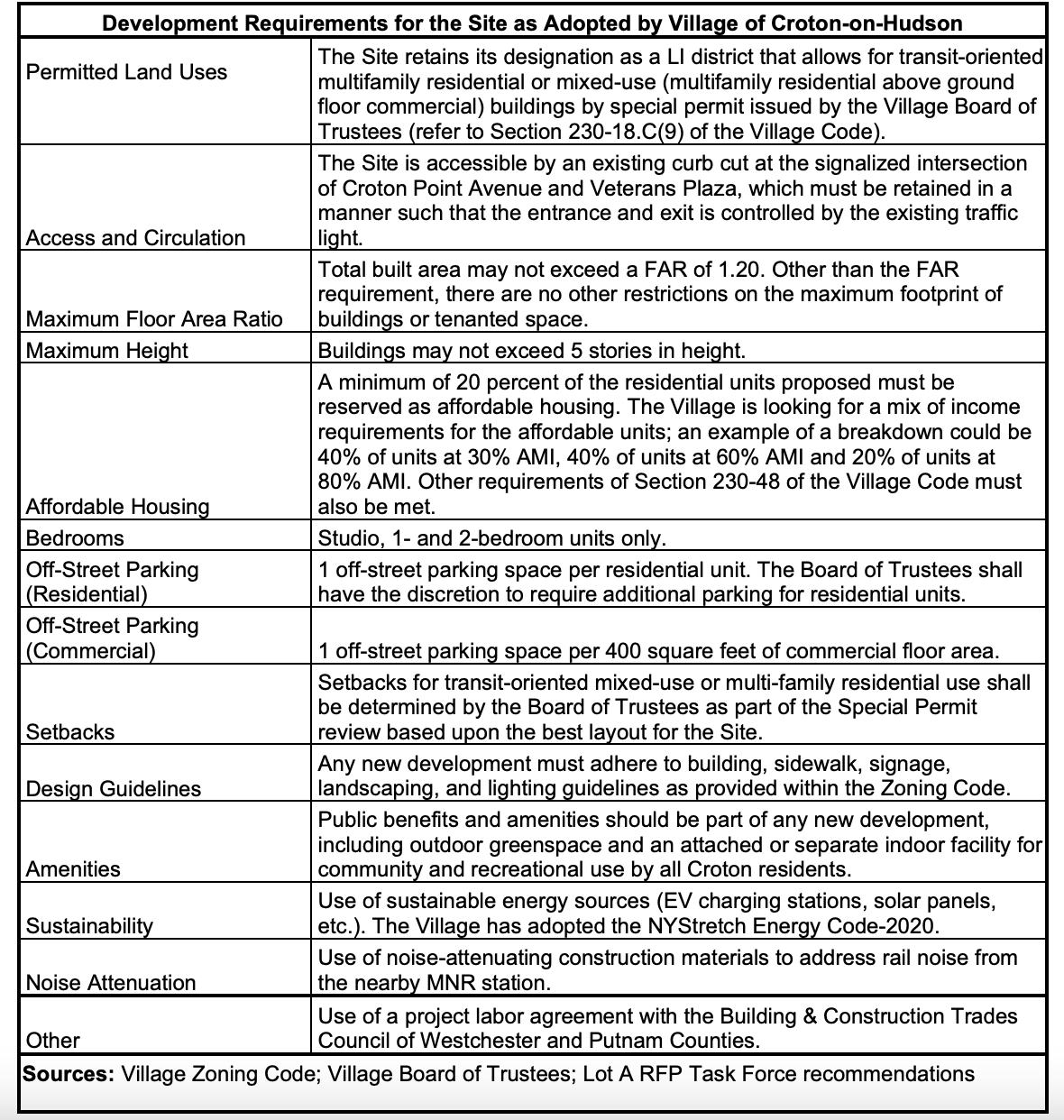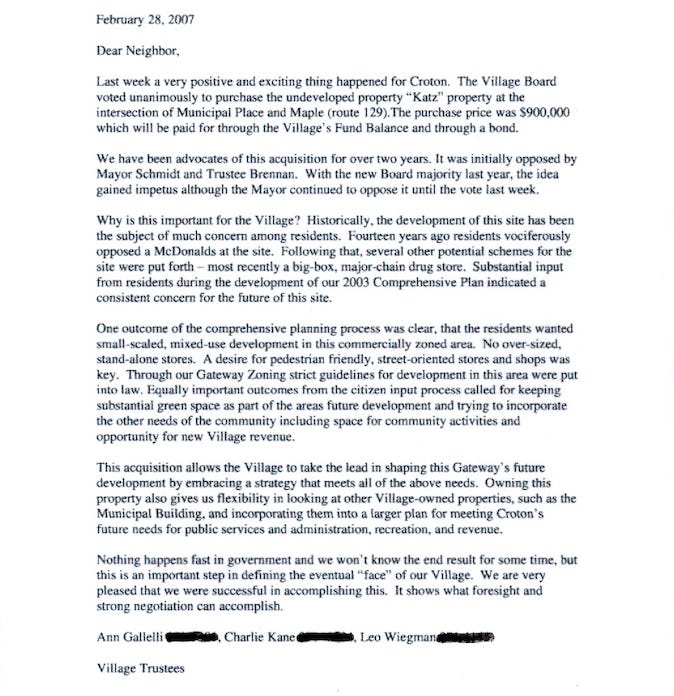The Crying of Parking Lot A
With apologies to Thomas Pynchon. The village has received “multiple” proposals to develop Lot A but won’t say what they are. Is transparency delayed transparency denied?
Last July, the village of Croton-on-Hudson issued a Request for Proposals (RFP) for Parking Lot A, a 1.225 acre, village owned property across Croton Point Avenue from the main entrance to the Croton-Harmon train station. According to village manager Bryan Healy, the village had received “multiple” proposals by the November 1 deadline, although Healy declined to tell the Chronicle anything about them when asked earlier this month.
Maria Cudequest, publisher of The New Everything Croton blog, received a similar response to a New York Freedom of Information Law request she filed around the same time:
“The Village is still in the process of reviewing proposals, therefore; your request is denied pursuant to Section 87(2)(c) of the Public Officers Law, as information which if disclosed would impair present or imminent contract awards or collective bargaining negotiations.
You have the right to appeal a denial of access to records within thirty (30) days to:
Bryan T. Healy, Village Manager”
Normally, there are reasonable arguments to be made that prematurely revealing the details of an ongoing negotiation with a possible buyer (or lessor?) could jeopardize the deal. However, that judgment is made by those with the authority to withhold the information, and it can be questioned.
A recent example where such a judgment might be considered to go against the best interests of the village and its residents is the sale of the so-called Finkelstein property at 1 Half Moon Bay Drive. Neither the sale, nor the nearly two-year long discussions with the developers about their plans to rezone the property for mixed residential/commercial use, were ever revealed to Crotonites by village leaders; that task fell to a blogger and this publication.
Moreover, there is nothing in the New York FOIL that requires officials to withhold information, except in situations where personal privacy could be jeopardized. Thus the decision to keep villagers in the dark about the proposals for Lot A until village officials decide it is the right moment—based on criteria that they and only they determine—is a purely discretionary choice. How that choice is made goes to the heart of open and transparent government, an increasingly contentious issue in Croton.
We will get back to the transparency issues shortly. But first, let’s see what can be determined about the plans for Lot A, based on the RFP itself.
The document opens with the recitation of certain “development objectives.” Among them are the desire to activate an underused parcel of land close to public transit “with residential or mixed-use land uses (including affordable housing)”; contribution of new property tax revenues; and, quoting in full here, “Assist in meeting the needs of Croton for public amenities by providing outdoor greenspace and an attached or separate indoor facility for community and recreational use by all Croton residents.” (boldface added.)
On a later page, the RFP gives a more detailed list of “development requirements,” and that is worth reproducing in full:
Note that the RFP specifies that projects can go up to five stories, and that a minimum of 20% of the units must meet the definitions of affordable housing. On the previous page, the document points out that an analysis by the village’s often-employed consultant, AKRF of White Plains, concluded that a five story development at maximum theoretical buildout in Lot A could accommodate 63 residential units and an equal number of parking spaces with no commercial space, and 51 residential units and approximately 51 parking spaces assuming the ground floor was used for commercial businesses.
Nowhere in the RFP is there further discussion of how the “outdoor greenspace and an attached or separate indoor facility for community and recreational use by all Croton residents” would or should fit into the plan.
If it seems cynical to assume that this very attractive possible feature of the Lot A development might either never come to pass or only in a very minimized form, one need only look at the village’s experience with the Katz project as a warning sign.
In 2007, when former trustee Ann Gallelli and other trustees were lobbying for the village to purchase the Katz property, a big “selling” point was a vision for “pedestrian friendly, street-oriented streets and shops,” and “substantial green space” as well as “space for community activities.”
What we have ended up with is something quite different: A maximally built out apartment complex, with a tiny “pocket park” at a very busy intersection that has already become the butt of village jokes about the “incredible shrinking green space.”
Hark back, for a moment, to the original vision:
One might argue that a lot has changed since 2007. The pandemic and the resulting loss of revenue from the main train station parking lots has put a crunch on village finances (although apparently we are now doing fairly well, showing a large budget surplus at the end of 2023); the shortage of affordable housing has created new political priorities that were not as urgent 17 or so years ago; and there is a growing desire, at least among some villagers, to diversify the largely white population (80%) of Croton with a greater racial and socioeconomic mix.
All of these priorities can be, and should be, debated openly and publicly. And according to long-time Crotonites, at one time they were, at least more than they are now. But apparently the last time the village held a large Town Hall on the issues of zoning and development, called by then mayor Leo Wiegman back in 2010, the result was not what village leaders expected. Instead of welcoming the proposed changes with open arms, one Crotonite recalls, “instead they got hundreds of angry residents screaming at them.”
And when the village did ask for the input of residents more recently, in the form of a survey conducted in spring of 2019, it again—at least in the views of many Crotonites the Chronicle has talked to—largely ignored the results. Here are the answers about developing the Katz property:
The “other” category, which got the most responses, is described in the survey results as follows:
“In the “Other” category, respondents expressed a mixed opinion on the future use of the site. In the 629 comments, several themes emerged. Many respondents reported that they do not support any changes to the area (“leave it as is”). The idea of creating some kind of public space was commonly reported. Some expressed the need for a public civic/park space and others preferred a passive green space which preserved the existing wooded character of the area. Some respondents wrote that the creation of park space could be done in conjunction with development. With regard to development, significant amount of respondents supported commercial uses in the area rather than residential uses.”
So how do Crotonites get input into planning decisions in the present day?
The primary mechanism left to villagers is to show up at a Board of Trustees or Planning Board meeting after a formal proposal or resolution has already been spelled out and speak for or against it—for a maximum of five minutes. This is what the more cynical among us call a “done deal.”
Of course, residents are free to organize, using their own means and devices, for or against a development plan, and that has sometimes happened. The opposition to the Hudson National Golf Club’s proposal to install a solar array that would have required the felling of hundreds of trees is an example of the way that a plan favored by the mayor and most of the Board can still be defeated (let there be no illusions that the club’s decision to withdraw the proposal was motivated by much more than public opposition.)
The question remains: Why are our village structures not maximalized for citizen input?
But for residents to do that requires they have relevant knowledge, and that knowledge has to be acquired far enough ahead of time so that it can be acted upon. Unfortunately, in the case of recent village developments, the practice has been to withhold critical information for as long as possible.
In future posts in The Croton Chronicle, we will explore the various motivations of our public officials and the reasons for the currently very pro-development stance most of them are taking. Some of those motivations may well be very laudable; others might be more questionable. But in the end, that is for the people of Croton to decide. Democracy does not end in the voting booth; it is, or should be, a way of life.
In our reporting on the Finkelstein plans, we tried to engage mayor Brian Pugh in a discussion about the need for transparency, and how decisions about what Croton residents should know and when they should know it are made. Such a discussion goes to the heart of a democracy, especially in a small community like ours. Pugh declined to have that discussion, but it still needs to take place.
Until it does, one might get the impression that our village leaders don’t trust the people of Croton to make the right judgments about village affairs.
In another context, the German playwright and poet Bertolt Brecht commented on just such a situation:
“Would it not in that case
Be simpler for the government
To dissolve the people
And elect another?”
(from Die Lösung, “The Solution”)
Comments policy: No personal attacks on anyone; please be polite and respectful.










Thank you for again bringing to light the need for communication and transparency between our elected officials and Croton residents.